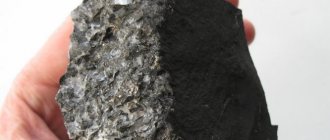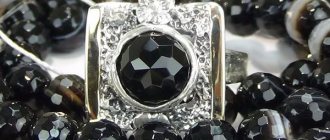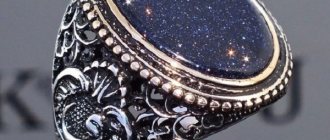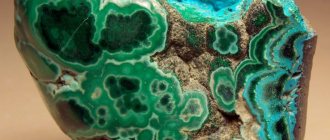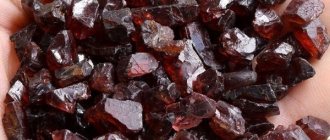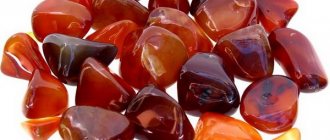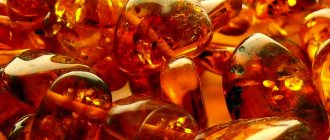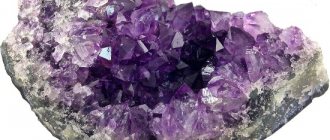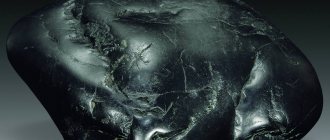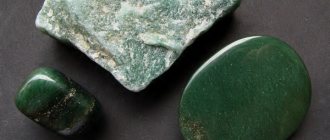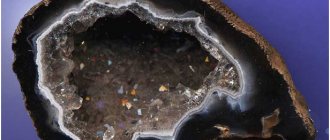Hello, friends.
In this article you will learn about the chemical composition and physical properties of shungite. It is from its unusual composition that all its magical, healing and cleansing properties are manifested.
We will also talk about the use of water purified with the help of this stone and about magical objects that you can use in your life.
According to scientific research, shungite is 2 billion years old. It is similar to coal, but lies in older layers of the earth's crust.
The mineral was formed during a period when there was nothing living on the planet. But in this case, the composition of shungite would be different, because it is formed due to carbon compounds. Only protobacteria could live in an oxygen-free environment.
Origin theories
Experts do not have a consensus on the origin of shungite. There are several main theories.
- Primitive microorganisms lived in the shallow waters of the ancient sea. Marine sediments absorbed their organic remains and this served as the basis for the formation of stone.
- There is also a fantastic theory according to which the mineral is a piece of a meteorite. It is believed that it broke away from a planet with an oxygen environment. The place where the meteorite fell served as a shungite deposit.
- Some scientists are inclined to believe that the mineral has characteristics of volcanic rocks. Therefore, lava emissions could contribute to the formation.
The properties of shungite are unique. Its healing properties were known back in the time of Peter I. The stone is used in construction as a lightweight concrete aggregate.
Non-stick paints and yellow phosphorus are made from it. In some cases it is used as a decorative material.
History of shungite
Shungite is a rock that was once based on organic deposits that were transformed into carbon during a long stay at great depths underground.
The structure of the stone is similar to graphite. Advertising - Continued below
The rock was first described several centuries ago: first in 1792 by academician N. Ya. Ozeretskovsky, and then in 1848 by mining engineer N. K. Komarov. Shungite was discovered in the Transonezh village of Shunga, in whose honor it received its name. Gave the name to the mineral A. A. Inostrantsev
In 1928, a state trust called “Shungite” was created and until 1937 the study of this rock was carried out. It was initially assumed that it had similar properties to coal.
Features of the composition
contains several different substances. This imbues the mineral with unique properties. That's why it is so widely used.
Experienced biologists have repeatedly observed how animals lick stones. It was believed that in this way they find salt and replenish sodium deficiency. But in the end, the study turned out that they eat shungite - this is how the body gets rid of unnecessary substances and receives the necessary elements.
The chemical composition of the stone includes:
- Magnesia;
- Sulfur;
- Oxides of iron, manganese, potassium;
- Alumina;
- Boron;
- Nickel;
- Copper and others.
The physical properties of the mineral are also unique.
It is characterized by high electrical conductivity and strength.
Despite its external fragility, it is resistant to aggressive substances and does not suffer from temperature changes.
It has good absorbent properties. They are effective against:
- Saprophytes;
- Phages;
- Bacterial cells.
Shungite has found application in various fields.
The unique composition gives the mineral various properties. It is used as a water filter and interior decoration.
Chemical composition of shungite
As part of this topic, you may also be interested in: radio-shielding plaster ALFAPOL SHT-1 and radio-shielding floor ALFAPOL AMSH »
SEZ for shungite of the Zazhoginsky deposit
Extract from : “ SHUNGITE POWDER. Technical conditions.
TU 2169-001-57753937-2002" 1. TECHNICAL REQUIREMENTS
1.1 Shungite powder must comply with the requirements of these Specifications and be manufactured according to technological regulations approved in the prescribed manner.
1.2 Shungite powder is produced in the following fractions:
from 0 to 0.10 µm, from 0.10 to 0.20 µm, from 0.20 to 60 µm
The specific value of the fractional composition of the powder supplied to the consumer is determined in the contract.
1.3 In terms of physical and chemical parameters, shungite powder must comply with the standards given in Table 1.
Table 1
| Indicator name | Norm |
| 1. Appearance | Fine black powder, without foreign impurities. |
| 2. Mass fraction of carbon, %, not less | 20 |
| 3. Mass fraction of losses at 105 °C, %, no more | 2,5 |
| 4. Ash content, %, no more | 75 |
| 5.Bulk density, g/dm³ | 400-500 |
| 6. pH of aqueous extract | 5,0-6,5 |
| 7. Mass fraction of residue, % after sifting through a sieve with mesh (no more) | |
| 0,14 | Absent |
| 0,045 | 0,05 |
| 8. Absorption of dibutyl phthalate, cm³/100g. | 25-35 |
| 9. Specific adsorption surface, m²/g | 15-20 |
1.3.1. Depending on the use of shungite powder, additional indicators can be introduced that determine the characteristics of the finished product.
2. SAFETY REQUIREMENTS
2.1 Shungite powder is not explosive, not flammable, and does not cause any reactions upon contact with human skin.
2.2 The maximum permissible concentration of dust in the air of the working area is 2.0 mg/m³.
2.3 During the production of shungite powder, packaging, loading and unloading operations, and at work sites, dust suspended in the air is formed. Personnel performing these operations must be provided with special clothing in accordance with GOST 12.4.016 and respirators in accordance with GOST 12.4.041.
2.4 Closed spaces where work with shungite powder is carried out must be equipped with ventilation that ensures that the dust content in the air is within the maximum permissible concentration.
2.5 Shungite powder is non-toxic and does not have a harmful effect on the environment.
2.6 Shungite powder is characterized by low radioactivity, which allows its use in all types of industrial products (NRB 99).
List of regulatory documents referenced in TU 2169-001-5773937-2002
Shungite powder
| Designation of a normative document | Name of the regulatory document |
| GOST 12.4.016-83 | SSBT. Special protective clothing. Nomenclature of quality indicators. |
| GOST 12.4.041-89 | SSBT. Filtering personal respiratory protection equipment. General technical conditions. |
| GOST 2226-88 | Paper bags. Technical conditions. |
| GOST 7328-2001 | Kettlebells. General technical conditions. |
| GOST 9147-80 | Porcelain laboratory utensils and equipment. Technical conditions. |
| GOST 14192-96 | Cargo marking. |
| GOST 18307-78 | Soot is white. Technical conditions. |
| GOST 24104-2001 | Laboratory scales. General technical conditions. |
| GOST 25336-82 | Laboratory glassware and equipment. Types, main parameters and sizes. |
| GOST 25699.1-90 | Rubber compound ingredients. Carbon black sampling method. |
| GOST 25699.4-90 | Carbon technical for rubber production. Method for determining the specific adsorption surface. |
| GOST 25699.5-90 | Carbon technical for rubber production. Method for determining the absorption of dibutyl phthalate. |
| GOST 25699.7-90 | Carbon technical for rubber production. Method for determining heating losses. |
| GOST 25699.8-90 | Carbon technical for rubber production. Method for determining ash content. |
| GOST 25699.10-93 | Carbon technical for rubber production. Method for determining the mass fraction of the residue after sifting through a sieve with mesh 0.045; 0.14 and 0.5 mm. |
| GOST 28498-90 | Liquid glass thermometers. General technical conditions. Test methods |
| OST 16.0.801.374-86 | Electric furnaces and resistance electric furnace units of periodic and continuous operation (except vacuum). |
| OST 16.0.801.397-87 | Laboratory electric resistance furnaces. |
| NRB-99 | Radiation safety standards. |
Table 1. Chemical composition of shungite used as a filler for shielding dry building mixtures TM ALFAPOL
| № | Element component | Symbol | Content % wt |
| 1 | Aluminium oxide | Al2O3 | 4.05 |
| 2 | Iron(III) oxide | Fe2O3 | 1.01 |
| 3 | Iron(II) oxide | FeO | 0,54 |
| 4 | Potassium oxide | K2O | 1,23 |
| 5 | Calcium oxide | Sao | 0,12 |
| 6 | Silicon oxide | SiO2 | 56.46 |
| 7 | Magnesium oxide | MgO | 0.56 |
| 8 | Manganese oxide | MnO | 0,12 |
| 9 | Sodium oxide | Na2O | 0,36 |
| 10 | Titanium oxide | TiO2 | 0,24 |
| 11 | Phosphorus oxide | Р2О5 | 0,05 |
| 12 | Barium | Va | 0,32 |
| 13 | Bor | B | 0,004 |
| 14 | Vanadium | V | 0,015 |
| 15 | Cobalt | Co | 0,00024 |
| 16 | Copper | Cu | 0,0037 |
| 17 | Molybdenum | Mo | 0,0011 |
| 18 | Arsenic | As | 0,00025 |
| 19 | Nickel | Ni | 0,0085 |
| 20 | Lead | Pb | 0,0023 |
| 21 | Sulfur | S | 0,57 |
| 22 | Strontium | Sr | 0,001 |
| 23 | Carbon | C | 26,26 |
| 24 | Chromium | Cr | 0,0078 |
| 25 | Zinc | Zn | 0,0067 |
| 26 | Humidity | H2O | 0,75 |
| 27 | H2O | 1,40 |
As part of this topic, you may also be interested in: radio-shielding plaster ALFAPOL SHT-1 and radio-shielding floor ALFAPOL AMSH »
Methods of using shungite water
To use the healing properties of the mineral, special water is prepared. To do this, liquid is collected into a glass or enamel container. It should be collected from trusted sources and, preferably, boiled beforehand.
Shungite stones are placed at the bottom at the rate of 100 g per 1 liter of water.
You can use the healing water after just a few hours, but it reaches its maximum effect after three days.
The finished infusion must be poured into another container; the used minerals with residual liquid are left in the old container. They can be reused.
Shungite water is used in different ways:
- For sore throats, it is used as a gargle.
- for skin pathologies, take baths with it.
- Compresses can speed up the healing of wounds and burns, and also soften calluses and corns.
- You can cook with water and use it as a cleanser. It rejuvenates and helps maintain facial tone.
Regular drinking of the infusion clears the lungs and bronchi of mucus, and breathing returns to normal. It also helps improve the functioning of the digestive tract. Shungite enhances the production of enzymes, promotes the digestion of food and the removal of toxins.
Properties of shungite stone
The shungite mineral is a rock - metamorphosed coal, embodying the transition stage of anthracite to graphite.
Its composition is 93-95% carbon, the rest is hydrogen, nitrogen, sulfur, and in small quantities it contains inclusions of nickel and tungsten, selenium and vanadium.
If we talk about what properties this mineral is noted for, then shungite is marked by a high percentage of electrical conductivity, its thermal conductivity is fixed at the level of 7500 cal. The hardness of the mineral varies from 3.5 to 4, and the density of the structure is 2.1-2.4 g/m3.
Its hardness allows it to be used as a facing material; due to its purifying properties, it is used as a filter; it is widely used in jewelry, and the use of gems for various design elements is also common.
| Properties | Description |
| Formula | WITH |
| Hardness | 4 |
| Kink | Conchoidal. |
| singonia | Tetragonal. |
| Shine | Semi-metallic. |
| Transparency | Opaque. |
| Color | Black, sometimes brown. |
Magic properties
The stone has found use among various kinds of esotericists. Depending on the form, it is used for different purposes.
Cube
Attracts cash flows and promotes business development. It gives a person determination and perseverance, which allows him to bring his plans to life.
Pyramids
They protect the house from dark magic and witchcraft. To protect against external influences, it is placed opposite the front door - this makes shungite a powerful amulet.
Some esotericists believe that the shungite pyramid is a portal to another world.
Therefore, it effectively interacts with subtle matters. When done correctly, a good energy channel can be established.
Ball
Allows you to establish personal relationships and bring this area into a harmonious state. Therefore, you can wear beads or any other jewelry made from this stone.
Shungite figurines
In the apartment, they absorb negativity and extinguish conflicts with quarrels. They help cope with apathy, fatigue, and headaches. Neutralizes depression.
Shungite is effective for meditation, as it allows you to direct thoughts in the right direction and frees you from negative energies. Promotes the spiritual development of a person and balances his aura.
That's all. I hope you liked this article. Therefore, leave comments and click on the social buttons below the article. Good luck to you.
Description of the mineral
According to scientists, shungite is considered one of the oldest rocks in the territory. Thanks to research, it was discovered that its geological age is at least two billion years.
In appearance, shungite resembles the most traditional hard coal of gray, dark gray or black color. There are matte and shiny different versions of shungite.
From the outside it is a rather ugly stone, but due to its chemical composition and physical characteristics, this mineral is considered truly inimitable in the area.
Place of Birth
It is very rare to find pure shungite today. It mainly appears in the form of thin veins, the width of which does not exceed 30 cm. It is found as an admixture in shungite shales and dolomites in Zaonezhie - from Girvas to Tolvui, Shunga.
Main shungite deposits:
- "Myagrozerskoye";
- "Shungskoye";
- "Maksovo";
- "Zazhogino";
- "Nigozerskoye";
- "Turastamozerskoe".
To date, a new deposit has been found in Kazakhstan - Koksuyskoye.
Origin story
Shungite has been used in medical practice since the beginning of the 18th century. Peter the Great was the first to believe in the properties of the mineral and began to insist on their use. He not only consumed infused water on his own, but also recommended giving it to soldiers in the army.
During long hikes, there was always shungite in the water, which purified the liquid, thereby preventing mass infectious epidemics. Today, scientists have been able to prove that the stone actually has unique antibacterial properties.
Since that time, the mineral began to be used as a pigment to create paint; it is marketed under the name “natural black shungite” or “soot.” Already in the 70s it became clear that small stone chips could be used as an insulating material.
To obtain shungizite, it was necessary to heat the stone to 1130°C, after which the filler became a low-density building material.
Shungite belongs to the mineraloids. It represents one of the earliest oil fields formed, dating back to the Precambrian era. The land around Lake Onega in western Russia, specifically the Republic of Karelia, is covered with rocks from the Paleoproterozoic period, which are about two billion years old. These include metamorphosed petroleum residues, including both shale sources and crude product.
Apparently, once upon a time a large area here was covered with salt water lagoons, which were located near a chain of volcanoes. As a result of the normal process of life, the ecosystem consisted of a huge number of single-celled algae.
In turn, the volcanoes produced the necessary nutrients for them. The deposits that appeared consisted of the remains of these microorganisms. Later, these rocks were subjected to increased temperature and pressure, which turned the oil into shungite.
What is shungite? Properties, extraction, application and price of shungite
Mikhail Romanov owes his birth to shungite. Peter the Great came to this conclusion when he learned how Queen Xenia suffered.
Boris Godunov's daughter was barren. She was exiled to the Goritsky convent. He stood on the banks of the Sheksna. There was also a spring in the waters of which Ksenia loved to bathe.
Later, the great-grandmother of Peter the 1st became pregnant and gave birth to Mikhail Romanov. He became the first king in the family.
The spring in which Ksenia bathed oozed from under the shungite boulders, absorbing its healing power.
But, we'll talk about it later. In the meantime, let’s figure out what the miraculous stone is.
What is shungite?
Shungite is a mineral that is a transitional stage from anthracite to graphite. The first is premium grade coal, in which the decay processes have completed and almost 100% of the composition is carbon.
It also makes up graphite, which is usually seen in pencils. Stone differs from coal only in the density of the carbon layers and the arrangement of atoms.
In shungite they are “compacted” even more densely. However, the crystal lattice, like that of carbon diamond, is not yet visible.
Therefore, Alexander Inostrantsev identified shungite stone as the extreme member in the series of non-crystalline natural carbons. However, there are rudimentary structures called fullerenes in the stone.
The mineral also owes its name to the Russian geologist Inostrantsev. The stone was called slate, drawing an analogy with the colors of the snake family.
Foreigners were connected by the mineral with the place where it was abundant. This is the village of Shunga. It was located beyond Lake Onega.
The properties of shungite stone were first studied using Onega samples. We are talking about a scientific “examination” of the mineral, and not popular speculation.
It turned out that, being a transitional stage from anthracite to graphite, shungite differs from them by a significant admixture of silica.
Silicon oxide accounts for up to 60% of the composition. Only 40% remains for non-crystalline carbon.
Moreover, in addition to quartz, the stone may also include other silicon minerals, for example, mica.
It turns out that the hero of the article is not a mineral at all, but a rock? In most cases, yes. Shungite is rarely found in its pure form.
Being composed of several independent minerals, the shungite rock also contains impurities.
Sulfur can account for up to 1.2%. Iron and aluminum oxides occupy approximately 3% each. The duet of titanium and oxygen claims 0.2%.
Accordingly, only 40% of shungite is transformed coal, the rest is elements of inorganic origin.
Properties of shungite
The rock is not similar to any other mineral. Shungite is not similar to other rocks. The stone is found in only one place on Earth, which leads scientists to think about the alien origin of the hero of the article.
Perhaps the Karelian deposits are a once fallen meteorite. The volume of the deposit indicates the size of the body, which was supposed to lead to disaster, covering the sky with clouds of dust, leaving a giant crater.
However, there is no evidence of this. Therefore, scientists assume that the hero of the article was formed, nevertheless, during geological processes, but which ones? It remains a mystery.
The fullerenes that make up shungite are also mysterious. The molecules consist of hundreds of carbon atoms, are hollow inside, and spherical in shape.
The surface of fullerenes consists of interlocking carbon hexagons, which resembles the surface of a soccer ball.
This structure is not typical for both organic and inorganic matter. Fullerenes are formed during lightning discharges, and a Nobel Prize was received for their discovery in shungite.
Fullerenes were also “found” tens of light years away from Earth, which again pushes for the theory of the extraterrestrial origin of the rock.
Be that as it may, fullerenes give materials the ability to attract foreign elements.
Therefore, to buy shungite as a sorbent. Porosity in the rock is no more than 6%. But fullerenes are better than any pores; they capture and hold, as they say, tightly.
In addition, fullerenes are capable of not only retaining substances, but also delivering them to the cells of the body. “Parcels” are placed on cell membranes.
An advantage to the work of fullerenes is the ion-exchange properties of shungite. The stone releases charged particles to air, water, and through them to living beings.
A shungite pyramid and other crafts send out negative ions, taking away positive ones instead.
The latter have a destructive effect on animals, causing aging and disease. Negative ions, on the contrary, heal and prolong life.
Shungite is distinguished by solid electrical conductivity. It is equal to 1500 siemens per meter. Thermal conductivity is also high.
These properties, as well as the ability to ion exchange, have applications. Which? We'll talk about this in a separate chapter.
We will conclude this with information about the low hardness of shungite. On the Mohs scale, it is equal to 4 points, which does not even reach the average mark.
The density is also below average - 2.1 grams per cubic centimeter. Hollow structures inside the stone make themselves felt.
Application of shungite
Shungite has found application in dozens of areas. The use of stone in medicine is obvious. Peter the Great ordered the establishment of a hospital near the shungite deposit.
Having learned the story of Queen Xenia, he ordered that pieces of rock be carried in soldiers’ bags in order to infuse water with shungite, which is rarely clean during military campaigns.
The stone disinfected drinking, and Peter’s army surprised its enemies with its health and physical strength.
In the 21st century, shungite continues to be used for water purification. The rock absorbs heavy metal ions and pollution.
Cleanses shungite and skin. Therefore, the stone is added to the cream. Shungite is present in it in its pure form, that is, as a mineral. Although, in nature, only the carbon formula of the hero of the article is rare.
In its usual form, shungite is useful in agriculture. Crushed stone reduces soil acidity and helps them retain moisture.
The sorption properties of the rock help with the latter. In areas with shungite, moisture is retained 2.5 times longer. Dolomite is also added to the “feeding”.
This mineral belongs to carbonates. Calcium content, by the way, is responsible for soil deoxidation. The role of shungite here is minimal.
But the rich composition of the hero of the article, in which, sometimes, the entire periodic table is found, gives the plants what they need for a rich harvest.
Thus, potato productivity in fields with shungite is 60-70% higher than in ordinary fields. Shungite flour is also given to indoor plants.
Motorists noted the healing properties of shungite , not only for people, but also for the planet.
In several dozen emergency areas, the pyramids from the hero of the article were buried underground. They were located under or near highways.
Scientists noticed that the “processed” areas are located near geotectonic faults. In such places there is a non-standard magnetic and radioactive background.
This quickens the pulse of motorists and disperses their attention. In general, most accidents occur not due to the fault of drivers, but due to the wishes of the planet.
However, shungite pyramids have a calming effect on her. It was possible to reduce the accident rate in Almaty, Germany, and Slovakia.
In Karaganda, they did not carry out road work, but after learning about the 30-35 percent loss of DDP from the experimenters, they began to recommend that drivers in the region acquire their own mini-pyramids made of shungite and take them with them on the road. Coincidence or not, shungite has received positive reviews.
Builders also speak positively about shungite. While pharmacists produce Shungite balm, joint remedies and all kinds of ointments, construction shungite is used for slabs for floors and walls.
Their hardness leaves much to be desired, but is quite operational. The main thing is that the high thermal conductivity of the hero of the article allows the floors to quickly warm up.
In most cases, you don’t even need to make them completely shungite. It is expensive. It is enough to cover the floor with paint based on rock powder and bring the wires to the coating.
Ceramic slabs are also coated with shungite paint. They become a screen for electromagnetic radiation, because the hero of the article is not magnetic, which is nonsense for most electrically conductive materials.
As a result, shungite has become a salvation in the construction of buildings that store secret data that requires protection.
In addition, the absorption of electromagnetic radiation by the rock has a positive effect on the well-being of employees working in offices crammed with computers and other equipment.
Shungite mining and deposits
The only explored shungite deposit is located in the Olonets region. In addition to the rock, there is also a pure mineral.
However, its veins do not exceed 30 centimeters in width. As a rule, it is 5-10 centimeters. The rest is rock mixed with shales and dolomites.
The upper layers of shungite deposits are destroyed by winds and water flows. As a result, the dense stone turns into earthy masses.
They are called Kizhi chernozem. In the North, soils are usually light. Chernozem is atypical. Moreover, the Kizhi version is more fertile than usual.
Shungite reserves in Karelia are 35,000,000 tons. Given the wide range of uses of the mineral separately and in rock, deposits are quickly consumed.
This motivates people to buy shungite and products made from it, because the price tag is constantly growing. Let's find out the current cost.
Shungite price
The price of shungite in its pure form depends on the sorting. So, for selected pieces about 5 centimeters long and wide they ask for 500-1000 rubles.
If you buy ready-made products, you will pay about 200 rubles for samples in the form of a pendant on a cord.
A shungite belt, recommended for rheumatism, costs around 500 rubles. Warming creams, also intended to relieve joint pain, are estimated at 200-1000 rubles per 100 gram tube.
A pyramid-amulet for your home and car can be purchased for 300-600 rubles. There are even shungite plates for smartphones. The devices, as you understand, dampen the radiation emanating from the phone and cost about 500 rubles.
Shungite jewelry
Shungite is used to make interesting jewelry. It is found at fairs and in online stores. Such decorations look very original.
Black stones go well with gray and yellow jewelry alloys. Sometimes they are framed in silver. They are made from minerals and beads.
Jewelry with shungite is universal. They are suitable for blondes and brunettes. Complements both evening and everyday looks.
Read the detailed article: shungite bracelets.
View this post on Instagram
Posted by Jewelry in stock and to order (@nelliinna) Jul 5, 2019 at 1:46 PDT
View this post on Instagram
Publication from BRACELETS FROM NATURAL STONES (@secrets_of_stones_) July 20, 2021 at 11:25 PDT
View this post on Instagram
Publication from the Stone Theater (@teatrkamnya) July 19, 2021 at 9:17 am PDT
Caring for stone products
In order for jewelry to retain its attractive appearance for a long time, it needs to be looked after regularly. Basic Rules:
- Jewelry with minerals is stored in a separate box, upholstered in soft fabric. If you put them together with other decorations, the appearance of the products will deteriorate.
- If the stone becomes dirty, wash it with warm soapy water. Moisture is removed with a soft dry cloth.
- It is important to protect products from mechanical damage. If you drop a stone, it will break.
The most useful stone
The healing properties of shungite are recognized both in lithotherapy and in traditional medicine. They are associated with its rich chemical composition, thanks to which the stone can influence a wide variety of processes in the body.
The stone will help activate metabolic processes.
The mineral, in particular, not only purifies water, but imparts its own healing properties to it. These include the following:
- Antioxidant - the ability to neutralize free radicals;
- Immunomodulatory - strengthening the immune system and the body's defenses;
- Antihistamines - suppression of allergic reactions;
- Bactericidal and sterilizing - destruction of pathogenic microbes;
- Anti-inflammatory;
- Filtering - the property of purifying water and air from toxins and waste, collecting them in itself (because of this, shungite needs to be washed periodically);
- Adsorbent - neutralization of harmful substances through their deposition and destruction;
- The ability to activate metabolic processes in the human body;
- Saturation of the body with useful microelements;
- Ability to relieve headaches;
- Favorable effect on sexual function;
- Stabilization of the emotional background, getting rid of nightmares and insomnia;
- Improving the functioning of all human organs and systems;
- Ability to clear the lungs;
- Elimination of the harmful effects of electromagnetic fields.
The health benefits of shungite surpass similar healing properties of almost all minerals. In lithotherapy it is used more widely than any other stone. In order for a crystal to begin to exert its therapeutic effects, it is not necessary to drink water purified with its help. Simple contact with the body is enough. Such procedures can relieve symptoms of diseases of the skin, musculoskeletal system, cardiovascular and respiratory systems.
Shungite pyramids can be kept in the house to reduce the strength of harmful electromagnetic radiation from a TV, computer and other household appliances. This minimizes their impact on the body.
Shungite water can also be used in different ways. They make inhalations, compresses, lotions with it, they prepare baths and food based on it. Some lithotherapists advise brewing healing infusions from medicinal herbs and mineral-purified water. However, there are some contraindications for such use - kidney stones or gall bladder, for example.
The crystal is also used in psychotherapeutic sessions. Being in a room decorated with stone helps patients relax, normalize their emotional background, and tune into trusting work with a specialist.
Medicinal properties
The healing properties of shungite have been used for a variety of purposes. Shungite deposits influence its healing properties. The Karelian mineral is considered the most effective; it has the most saturated structure with fullerenes - the main active particles. What gives shungite its healing properties:
- Manganese. It has a positive effect on nerve conduction and has a strengthening effect on the myelin sheath of neurons.
- Magnesium. It has a complex effect on the nervous system. Reduces nervous excitability, eliminates anxiety and depression. Positively affects the overall emotional state and softens the response to stress factors.
- Potassium. It is a catalyst for electrical impulses in muscle tissue, improves the functioning of the heart: normalizes blood pressure, evens out the heart rhythm.
- Silicon. Helps vitamins be absorbed in greater concentration.
- Copper. It has a positive effect on the complex functioning of all organ systems: digestive, excretory, cardiovascular, neurohumoral, etc.
- Zinc. Participates in immune reactions and cleanses the blood composition.
- Iron. Increases oxygen saturation of body cells.
For what diseases will the use of shungite be effective:
- Hypertension.
- Joint diseases.
- Muscle pain.
- Diseases of the gastrointestinal tract (gastrointestinal tract)
- Colds.
- Diabetes.
In most cases, shungite water is used for treatment. It can be purchased in specialized stores, pharmacies or made independently. Instructions for use are determined individually, based on the nature of the disease and the current condition of the patient. Since the mineral is a fairly active adsorbent and has many beneficial properties, it has a small list of contraindications:
- Chronic diseases in the acute stage.
- Oncology.
- Individual intolerance.
What is shungite and how is it useful?
Shungite is a rock whose origin is still unknown. According to scientists, its age reaches 2 billion years.
The mineral is a cross between coal, anthracite and graphite. It, like these rocks, consists of carbon, but includes a number of impurities:
- iron;
- manganese;
- alumina;
- potassium;
- zinc;
- sulfur;
- molybdenum;
- nickel;
- boron;
- magnesium;
- calcium;
- copper;
- chromium;
- cobalt;
- vanadium.
The color of shungite varies from black to gray. Moreover, it is the dark specimens that are considered the most valuable.
Unprocessed minerals have no aesthetic appeal. They look like lumps of dirty coal. Sometimes they have a metallic sheen, but more often they are matte.
The mineral helps normalize the functioning of internal organs, rejuvenates the body, improves the condition of the skin and hair, and evens out the psycho-emotional state.
To watch a video review about an amazing stone:
Types and colors of stone
The breed is divided into varieties based on several parameters. The predominant substance in the composition of the mineral is one of the parameters underlying the classification:
- siliceous;
- aluminosilicate;
- carbonate.
Based on the amount of carbon, crystals are divided into low-carbon and high-carbon. Stones with lower carbon content are used for decorative items and industrial purposes. High carbon samples are used for treatment.
According to another classification, elite and non-elite shungite are distinguished.
Black stones are considered elite, they are saturated with useful microelements and have higher strength. Granite-colored specimens are less useful.
How to distinguish real shungite from a fake
The healing and magical properties for which the mineral is valued are inherent only in natural samples of the rock. Although the price of shungite is low, dishonest sellers still counterfeit it, passing off ordinary coal or a similar-looking but useless rock - shungizite - as a crystal.
You should know how to distinguish a real copy from a fake:
- The feature of the mineral that distinguishes it from most other stones is that it conducts electricity. A fake cannot do this.
- The surface of the gem is matte and never shines. Because of its fragility, no one polishes it.
- Place your purchase in a cup of water. If the mineral is genuine, bubbles will soon appear on the surface of the liquid. This will mean that the cleansing process has begun.
- Pay attention to what shungite looks like - in a real healing crystal you can see thin golden veins of iron sulfate. They give the mineral additional therapeutic properties.
Due to the healing properties of shungite stone and its low cost, it was previously sold not in jewelry stores, but in pharmacies. However, specimens from there were often low-carbon or even fake.
Now the mineral can be purchased in various stores selling health products. When purchasing, it is best to always ask for a certificate. This will reduce the likelihood of fraud to a minimum.
Shungite and zodiac signs
Anyone who tries to use a mineral for a protective purpose or to implement plans will wonder whether the stone can help personally. The astrological properties of the stone are suitable for most zodiac signs, but there are a select few who benefit from the gem.
(“++” – the stone fits perfectly, “+” – can be worn, “-” – is strictly contraindicated):
| Zodiac sign | Compatibility |
| Aries | ++ |
| Taurus | + |
| Twins | ++ |
| Cancer | — |
| a lion | ++ |
| Virgo | — |
| Scales | — |
| Scorpion | + |
| Sagittarius | ++ |
| Capricorn | — |
| Aquarius | + |
| Fish | + |
